Search
High in protein and low in fat, turkey makes a healthy meal year round. It’s so versatile, you can use it to replace chicken in roasted recipes and as a healthier alternative to ground beef in meatloaf and burger recipes!
White Meat vs. Dark Meat Debate
While it’s true that dark meat contains more calories and fat than white meat, the difference is very small. Here are the facts: An ounce of roasted, skinless white meat turkey breast contains 44 calories and 1 gram of fat. And an ounce of roasted, skinless dark meat turkey (which is also moister and higher in iron) contains 52 calories and 2 grams of fat. So the difference between the two in a typical six-ounce serving of turkey comes to under 50 calories.
When it comes down to it, eat what you prefer! I will take the drumstick, please!!
Buying, Prepping, & Storage

When choosing a whole turkey, allow for at least 1 pound of meat per person.
Fresh turkey should be free of any odor and have clean skin with no pinfeathers.
Frozen turkey should have a plump breast and be wrapped in airtight packaging.
Always buy on or before the “sell by” date, then prepare or freeze it as soon as possible before the “sell by” date.
Cooking Tips
Make sure your pan (or your turkey) isn’t too large for your oven, If your pan is too deep it may block the heat from circulating.
Placing foil over a roast turkey can slow the cooking time, while an oven cooking bag can speed it up.
Brush the turkey with melted butter and rub with salt and pepper (and other spices like poultry seasoning) before cooking to add flavor, help with browning, and lock in some of the juices.
Turkey is fully cooked when it is no longer pink inside.

